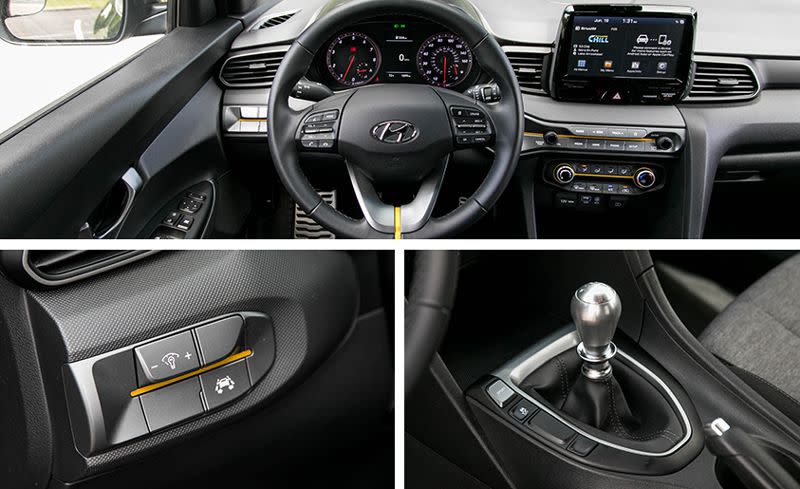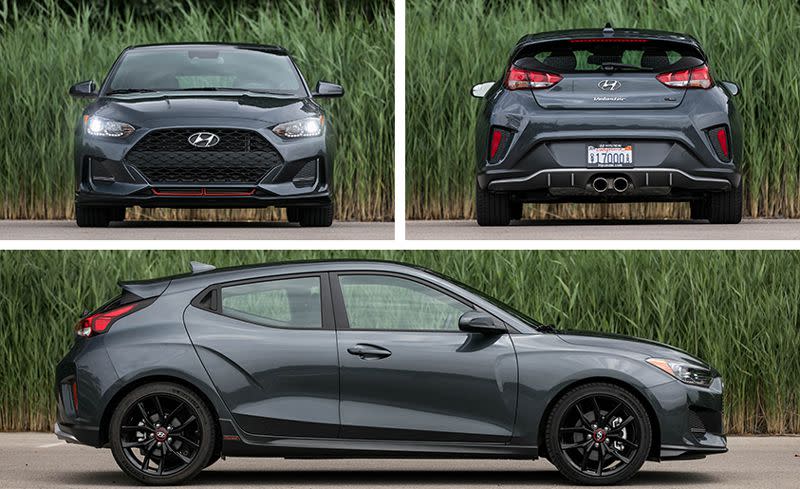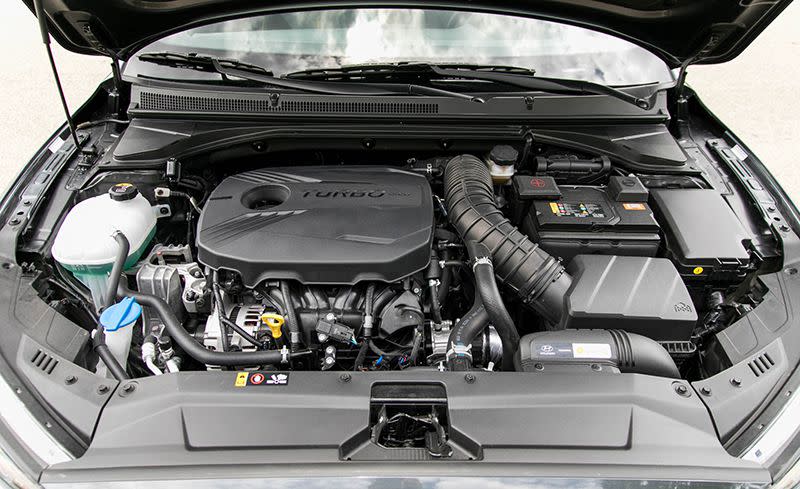The New Hyundai Veloster Is Much Better, but It’s Still Not Quite the Best

Someday soon, we expect a Hyundai product to top its class without trading on “great value” as its primary attribute. We’re closer than ever to that day. Touting a multilink rear suspension in place of its predecessor’s torsion-beam axle, a nicer interior, and a more muscular appearance that belies an underlying weight-loss program, the second-generation 2019 Hyundai Veloster Turbo R-Spec performs well, yet it still substitutes a lower price for the finer allures that put the Honda Civic Si and the Volkswagen Golf GTI on our 2018 10Best Cars list.
Its asymmetrical three-door configuration and hyena-like stance proclaim the Veloster’s role as a sportier coupe-like variant of the conventional Elantra GT hatchback, analogous to the way the late VW Scirocco stood in relation to the Golf. For the model’s sophomore outing, Hyundai has optimized the design with a more toothsome face and muscular haunches while also making it a little more practical by expanding cargo volume from only 16 cubic feet to 20, eight more than you’ll find in a Civic Si coupe. It’s a neat bit of packaging, considering the wheelbase hasn’t changed and the car is actually a shade shorter than the original, while its roof looks more steeply raked, giving the sense that the Veloster is always going uphill.
Upward is also where the interior designers were focused, employing better grades of plastic and fabric in the nicely finished cabin. Colored accents on the dash, steering wheel, and seat stitching make things considerably more interesting to look at than in the Elantra GT.
The Veloster Turbo shares its new rear suspension and carry-over 201-hp turbocharged 1.6-liter inline four with the Elantra GT Sport. This suspension improves on the original with more refined handling and a smoother ride, even with the Turbo’s stiffer anti-roll bars and dampers. Aluminum suspension components reduce unsprung mass and contribute to this car weighing 39 pounds less than the lightest first-gen Veloster we tested, a 2016 Rally Edition, and 212 pounds less than the Elantra GT Sport. The setup makes good use of the Michelin Pilot Sport 4 tires, serious performance rubber that’s standard on this driver-focused R-Spec trim (and on the manual-transmission Turbo Ultimate). Like the Si, the R-Spec comes only with a six-speed manual gearbox, also shared with the Elantra, and it’s enhanced with a standard B&M short-throw shifter (an option on other Hyundais using this gearbox).
The Numbers Are There
Weight-paring and sticky rubber help this R-Spec scoot to 60 mph in 6.2 seconds, whereas the ’16 needed 6.7 with the same powertrain. Thanks in large part to the Michelins, skidpad grip jumps to 0.95 g from 0.85 and stopping from 70 mph takes only 151 feet versus 173. The Veloster R-Spec plays in a league withthe 205-hp Civic Si coupe (6.3 seconds to 60 mph, 0.97 g, and 159 feet) and the 220-hp GTI (5.7 seconds, 0.95 g, 161 feet). The 268-hp Subaru WRX is the class hot rod with a zippy 5.5-second acceleration to 60 mph (we’ve even seen 5.0 in earlier examples), but the Subie is in the middle of the pack in roadholding and braking.
The Veloster’s packaging makes it a little smaller than those three in the passenger compartment, a fair tradeoff for being lighter. The Hyundai is bigger than the Ford Fiesta ST, which has a more directly comparable 197-hp turbocharged 1.6-liter four, but is vanishing from the U.S. market after 2018. For the record, the most recent ST we tested took 6.9 seconds to hit 60 mph, generated 0.93 g, and stopped in 166 feet.
A Button to Complexify and Add Loudness
Track numbers won’t tell you that the Veloster’s steering lacks on-center precision even in its heftier Sport driving mode, which really should be the single setting, and it still lacks for feel through the electrically assisted system that mounts its motor on the column. Engineers have given their lighter car a stiffer chassis, which all but erases the body flex that plagued the original when pressing hard on twisting roads. Once off-center, the steering is more predictable and consistent than before-but being better doesn’t equal “best.”
Even in R-Spec trim, the Veloster is not especially eager to turn in or to rotate despite the assistance of brake-actuated torque vectoring. Our test driver cited the car’s superb at-the-limits balance on the skidpad, but that applies only after speeds get scary fast out on the road-at saner velocities, the car’s tail stays resolutely stuck and you can’t really adjust your cornering line with lift-throttle or braking tricks. This puppy won’t wag its tail and just isn’t as playful as its toylike appearance suggests, a downside of today’s mega-grippy tires.
The Sport mode button on the console just ahead of and to the left of the shifter also adjusts the exhaust note and, in Veloster Turbos equipped with the seven-speed dual-clutch automatic, the shift programming. That latter doesn’t apply to the manual-only R-Spec though, so having a mode button at all really seems superfluous. The exhaust note is aggressive enough for most in the standard setting, particularly since this engine is not particularly characterful, and even the audio system’s amplified version seems to add noise without musicality. The engine is plenty flexible with abundant low-range torque so that you needn’t shift gears often, even in heavy traffic, but neither does it reward winding it out to the 6750-rpm redline. The short-throw shifter feels sportier than the Elantra’s (which reminds us of Grandma’s Plymouths), but it slips into each gate with a slightly muddier sensation than the crisp engagement you get in the Honda.
The Value Proposition Still Rules
The R-Spec comes one way, stuffed with standard equipment for $23,785. The Honda opens at $24,995, the VW at $27,265, and the Subaru at $27,885. The price gaps can grow when you equip competitive cars as fully as the Hyundai (even the tiny Fiesta ST, which starts at $22,160, cost $25,775 in its most recent as-tested form).
The basics here are so close to being on-point that we’re looking forward to the upcoming 275-hp Veloster N, which will have such as niceties adaptive damping and multiple driving modes. Here’s hoping the new N performance division looks beyond the number behind the dollar sign to get all of its sums right.
You Might Also Like

 Yahoo Autos
Yahoo Autos 


